The Evolution of Strength Training

Shifting gears in this post, we want to share a bit more about the history of strength training. This will hopefully provide a benchmark for how far the field has come, and how new weight room technology is to it. You’ll see that weight room technology, and velocity based training (vbt) devices like Perch are still in their infancy. But you’ll also see the impact technology has had in a short period of time. Let’s dive in!
Strength training has a long and fascinating history, dating back thousands of years. From ancient Greek athletes to modern-day bodybuilders, people have been exploring ways to build and maintain strength for both practical performance and aesthetic reasons.
In this blog post, we’ll take a closer look at the origins and evolution of strength training, tracing its development from ancient times to the present day.
Ancient Strength Training: The Origins
The earliest records of strength training date back to ancient times, when athletes and warriors developed specialized exercises to build strength and power. In ancient Greece, athletes trained using weights made of stone or metal, as well as bodyweight exercises like push-ups, pull-ups, and squats.
One of the most famous early strength athletes was Milo of Croton, a Greek wrestler who lived in the 6th century BCE. Milo is said to have trained by carrying a calf on his shoulders every day until it grew into a full-grown bull, an impressive feat that required immense strength and endurance.
In ancient China, strength training was also an important component of martial arts training. Chinese warriors developed specialized exercises to build strength, speed, and agility, including bodyweight movements like squats, lunges, and push-ups, as well as weapons training with swords and spears.
Strength Training in the Middle Ages and Renaissance
During the Middle Ages and Renaissance, strength training took on new forms as knights and soldiers trained for battle. Weightlifting and other strength exercises were still used, but with the added focus on building functional strength and agility for use in combat.
One notable figure from this era was the German knight and fencing master Joachim Meyer, who wrote extensively about the benefits of strength training for sword fighting. In his book "The Art of Combat," Meyer emphasized the importance of strength and fitness for success in battle, and recommended exercises like running, jumping, and weightlifting to build strength and endurance.
Strength Training in the Modern Era
The modern era of strength training began in the 19th century with the emergence of organized weightlifting competitions. In 1896, weightlifting was included in the first modern Olympic Games, and it has been a staple of the games ever since. During the early 20th century, strength training became increasingly popular among athletes, with many using weightlifting and other forms of strength training to improve their performance in sports like football, track and field, and wrestling.
One of the most famous strength athletes of this era was Eugene Sandow, a British bodybuilder who is often referred to as the "father of modern bodybuilding." Sandow was known for his impressive physique and strength, and he helped popularize the idea of using weightlifting and other forms of strength training to build muscle and improve overall fitness.
Strength training continued to evolve throughout the 20th century, with the development of new equipment and training techniques. Bodybuilding competitions became increasingly popular, and new exercises like the bench press, deadlift, and squat were introduced. In the 1960s and 1970s, strength training became more mainstream, with the emergence of popular fitness programs like Jack LaLanne's TV show and the "bodybuilding boom" of the 1970s. During this time, many people began to see strength training as a way to improve their overall health and fitness, rather than just for building muscle.
Today, strength training remains a popular form of exercise, with people of all ages and fitness levels using it to improve their physical health and well-being. This ranges from young kids learning efficient movement patterns, to professional athletes, and general population and even geriatric population. Everyone can benefit from getting stronger and maintaining movement patterns.
Like it or not, we are now in the technology age of strength training, with new AI tools like Tonal and connected fitness like Tempo. And aside from at home strength training technology, weight room technology using existing weight rack equipment is burgeoning as well. Think about force plates, velocity based training, heart rate and GPS. All of these come together to give coaches a 360 view of athlete performance. And we are only just getting started.
From Olympic weightlifters to everyday gym-goers, strength training has come a long way from its ancient roots, but it remains an important part of human history and culture. And we cannot wait to see what happens next.
Conclusion
Strength training has a rich and fascinating history that spans thousands of years. From ancient Greek athletes and Chinese warriors to modern-day bodybuilders, gym-goers, and athletes, people have long been exploring ways to build and maintain strength for both practical and aesthetic reasons.
The evolution of strength training has been shaped by cultural, social, and technological changes, but its core purpose of building strength and improving physical health and performance has remained constant throughout history. Today, strength training continues to be an important part of many people's fitness routines, and it will undoubtedly continue to evolve and change in the years to come.
Read more about Perch here! And check out Product Videos here. And our support website here.
Back to basics? Review the origins of VBT and Strength Training!
Sources:
- "The Origins of Strength Training" by Doug Dupont, Breaking Muscle, https://breakingmuscle.com/fitness/the-origins-of-strength-training.
- "A Brief History of Strength Training" by Christopher E. Harrison, Strength and Conditioning Journal, https://journals.lww.com/nsca-scj/fulltext/2010/06000/A_Brief_History_of_Strength_Training.1.aspx.
- "A Brief History of Strength Training" by K. Travis Skinner, American Council on Exercise, https://www.acefitness.org/education-and-resources/professional/expert-articles/5328/a-brief-history-of-strength-training/.
- "The History of Strength Training" by Charles Staley, T Nation, https://www.t-nation.com/training/history-of-strength-training.
- "A Short History of Strength Training" by Menno Henselmans, Bayesian Bodybuilding, https://bayesianbodybuilding.com/history-of-strength-training/.

Start Gathering Data With Perch Today!
Reach out to us to speak with a representative and get started using Perch in your facility.








































































.avif)

































